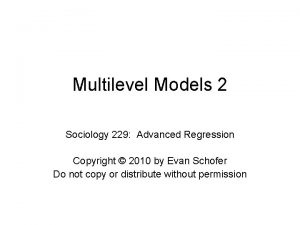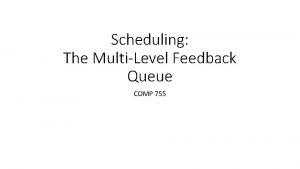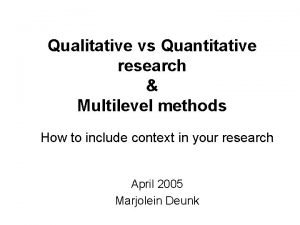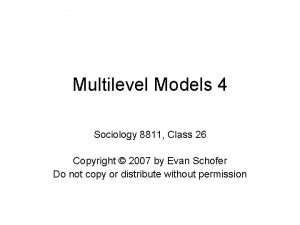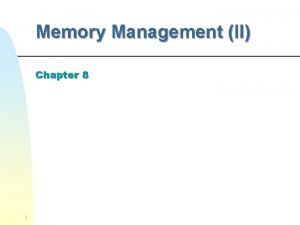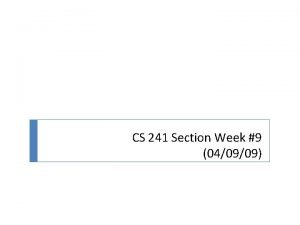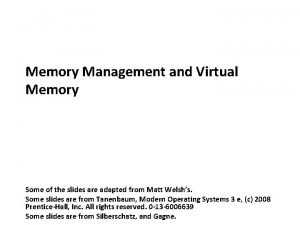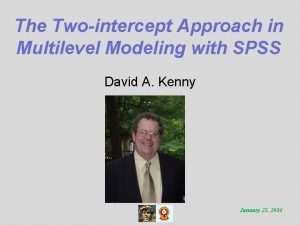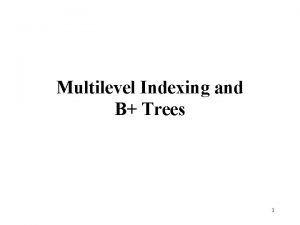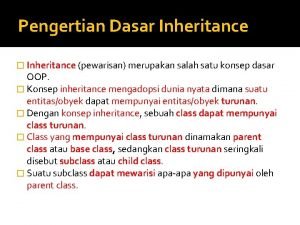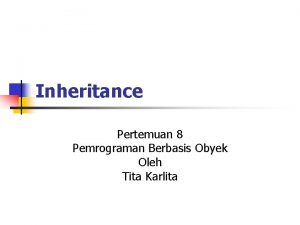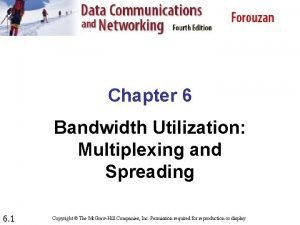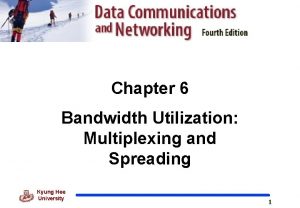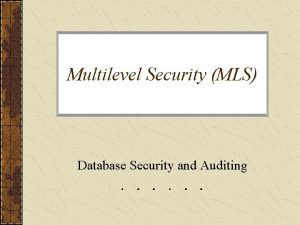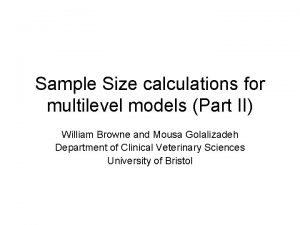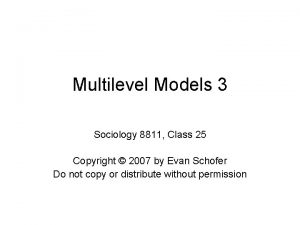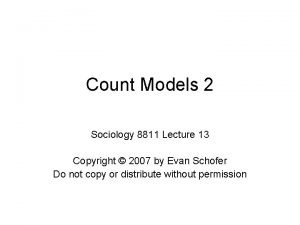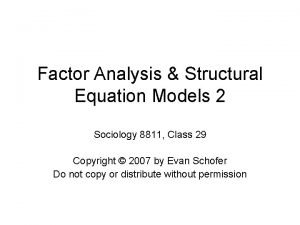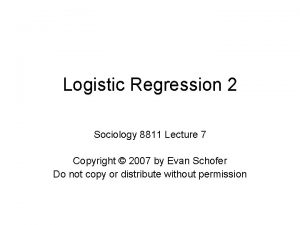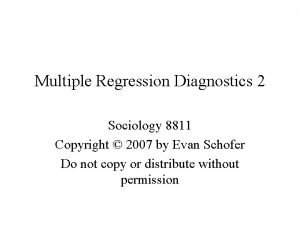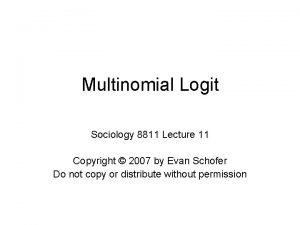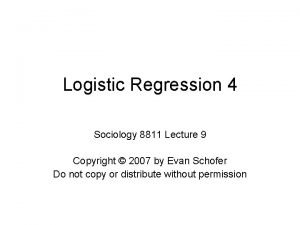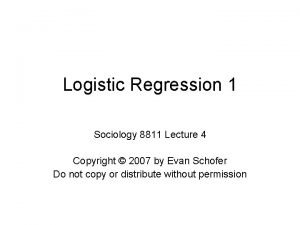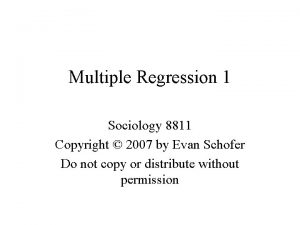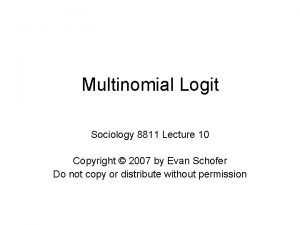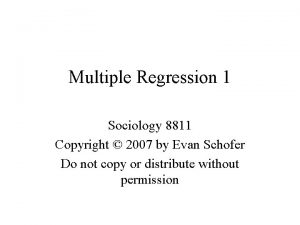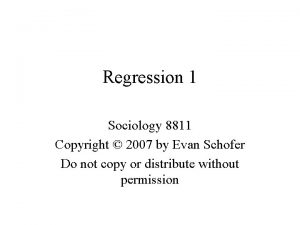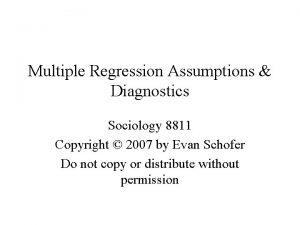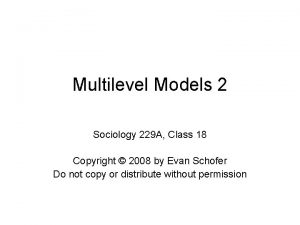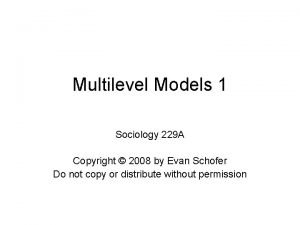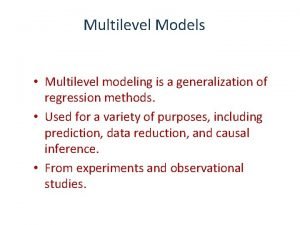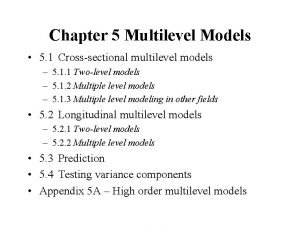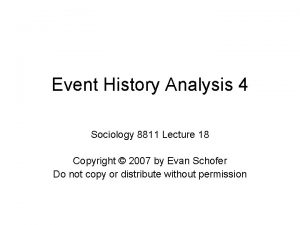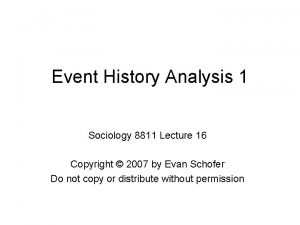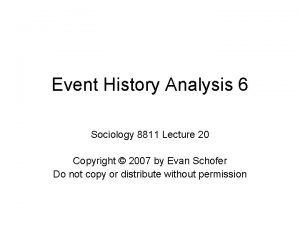Multilevel Models 2 Sociology 8811 Class 24 Copyright

































- Slides: 33

Multilevel Models 2 Sociology 8811, Class 24 Copyright © 2007 by Evan Schofer Do not copy or distribute without permission

Announcements • Paper #2 due in 2 weeks • Come see me ASAP if you don’t have a plan • Unfortunately, I’m unavailable during office hours today – Please send me an email to make an appointment at some other time.

Multilevel Data • Simple example: 2 -level data Class Class • Which can be shown as: Class 1 Level 2 Level 1 S 2 Class 2 S 3 S 1 S 2 Class 3 S 1 S 2 S 3

Review: Multilevel Strategies • Problems of multilevel models • Non-independence; correlated error • Standard errors = underestimated • Solutions: – Each has benefits, disadvantages… • • • 1. 2. 3. 4. 5. 6. OLS regression Aggregation (between effects model) Robust Standard Errors Robust Cluster Standard Errors Dummy variables (Fixed Effects Model) Random effects models

Example: Pro-environmental values • Source: World Values Survey (27 countries) • Let’s simply try OLS regression. reg supportenv age male dmar demp educ incomerel ses Source | SS df MS -------+---------------Model | 2761. 86228 7 394. 551755 Residual | 105404. 878 27799 3. 79167876 -------+---------------Total | 108166. 74 27806 3. 89005036 Number of obs F( 7, 27799) Prob > F R-squared Adj R-squared Root MSE = = = 27807 104. 06 0. 0000 0. 0255 0. 0253 1. 9472 ---------------------------------------supportenv | Coef. Std. Err. t P>|t| [95% Conf. Interval] -------+--------------------------------age | -. 0021927. 000803 -2. 73 0. 006 -. 0037666 -. 0006187 male |. 0960975. 0236758 4. 06 0. 000. 0496918. 1425032 dmar |. 0959759. 02527 3. 80 0. 000. 0464455. 1455063 demp | -. 1226363. 0254293 -4. 82 0. 000 -. 172479 -. 0727937 educ |. 1117587. 0058261 19. 18 0. 000. 1003393. 1231781 incomerel |. 0131716. 0056011 2. 35 0. 019. 0021931. 0241501 ses |. 0922855. 0134349 6. 87 0. 000. 0659525. 1186186 _cons | 5. 742023. 0518026 110. 84 0. 000 5. 640487 5. 843559

Dummy Variables • Another solution to correlated error within groups/clusters: Add dummy variables • Include a dummy variable for each Level-2 group, to explicitly model variance in means • A simple version of a “fixed effects” model (see below) • Ex: Student achievement; data from 3 classes • Level 1: students; Level 2: classroom • Create dummy variables for each class – Include all but one dummy variable in the model – Or include all dummies and suppress the intercept

Dummy Variables • What is the consequence of adding group dummy variables? • A separate intercept is estimated for each group • Correlated error is absorbed into intercept – Groups won’t systematically fall above or below the regression line • In fact, all “between group” variation (not just error) is absorbed into the intercept – Thus, other variables are really just looking at within group effects – This can be good or bad, depending on your goals.

Example: Pro-environmental values • Dummy variable model. reg supportenv age male dmar demp educ incomerel ses _Icountry* Source | SS df MS -------+---------------Model | 11024. 1401 32 344. 504377 Residual | 97142. 6001 27774 3. 49760928 -------+---------------Total | 108166. 74 27806 3. 89005036 Number of obs F( 32, 27774) Prob > F R-squared Adj R-squared Root MSE = = = 27807 98. 50 0. 0000 0. 1019 0. 1009 1. 8702 ---------------------------------------supportenv | Coef. Std. Err. t P>|t| [95% Conf. Interval] -------+--------------------------------age | -. 0038917. 0008158 -4. 77 0. 000 -. 0054906 -. 0022927 male |. 0979514. 0229672 4. 26 0. 000. 0529346. 1429683 dmar |. 0024493. 0252179 0. 10 0. 923 -. 046979. 0518777 demp | -. 0733992. 0252937 -2. 90 0. 004 -. 1229761 -. 0238223 educ |. 0856092. 0061574 13. 90 0. 000. 0735404. 097678 incomerel |. 0088841. 0059384 1. 50 0. 135 -. 0027554. 0205237 ses |. 1318295. 0134313 9. 82 0. 000. 1055036. 1581554 _Icountry_32 | -. 4775214. 085175 -5. 61 0. 000 -. 6444687 -. 3105742 _Icountry_50 |. 3943565. 0844248 4. 67 0. 000. 2288798. 5598332 _Icountry_70 |. 1696262. 0865254 1. 96 0. 050. 0000321. 3392203 … dummies omitted … _Icountr~891 |. 243995. 0802556 3. 04 0. 002. 08669. 4012999 _cons | 5. 848789. 082609 70. 80 0. 000 5. 686872 6. 010707

Dummy Variables • Benefits of the dummy variable approach • It is simple – Just estimate a different intercept for each group • sometimes the dummy interpretations can be of interest • Weaknesses • Cumbersome if you have many groups • Uses up lots of degrees of freedom (not parsimonious) • Makes it hard to look at other kinds of group dummies – Non-varying group variables = collinear with dummies • Can be problematic if your main interest is to study effects of variables across groups – Dummies purge that variation… focus on within-group variation – If you don’t have much within group variation, there isn’t much left to analyze.

Dummy Variables • Note: Dummy variables are a simple example of a “fixed effects” model (FEM) • Effect of each group is modeled as a “fixed effect” rather than a random variable • Also can be thought of as the “within-group” estimator – Looks purely at variation within groups – Stata can do a Fixed Effects Model without the effort of using all the dummy variables • Simply request the “fixed effects” estimator in xtreg.

Fixed Effects Model (FEM) • Fixed effects model: • For i cases within j groups • Therefore aj is a separate intercept for each group • It is equivalent to solely at within-group variation: • X-bar-sub-j is mean of X for group j, etc • Model is “within group” because all variables are centered around mean of each group.

Fixed Effects Model (FEM) . xtreg supportenv age male dmar demp educ incomerel ses, i(country) fe Fixed-effects (within) regression Group variable (i): country Number of obs Number of groups = = 27807 26 R-sq: Obs per group: min = avg = max = 511 1069. 5 2154 within = 0. 0220 between = 0. 0368 overall = 0. 0239 F(7, 27774) = 89. 23 corr(u_i, Xb) = 0. 0213 Prob > F = 0. 0000 ---------------------------------------supportenv | Coef. Std. Err. t P>|t| [95% Conf. Interval] -------+--------------------------------age | -. 0038917. 0008158 -4. 77 0. 000 -. 0054906 -. 0022927 male |. 0979514. 0229672 4. 26 0. 000. 0529346. 1429683 dmar |. 0024493. 0252179 0. 10 0. 923 -. 046979. 0518777 demp | -. 0733992. 0252937 -2. 90 0. 004 -. 1229761 -. 0238223 educ |. 0856092. 0061574 13. 90 0. 000. 0735404. 097678 incomerel |. 0088841. 0059384 1. 50 0. 135 -. 0027554. 0205237 ses |. 1318295. 0134313 9. 82 0. 000. 1055036. 1581554 _cons | 5. 878524. 052746 111. 45 0. 000 5. 775139 5. 981908 -------+--------------------------------sigma_u |. 55408807 Identical to dummy variable model! sigma_e | 1. 8701896 rho |. 08069488 (fraction of variance due to u_i) ---------------------------------------F test that all u_i=0: F(25, 27774) = 94. 49 Prob > F = 0. 0000

ANOVA: A Digression • Suppose you wish to model variable Y for j groups (clusters) • Ex: Wages for different racial groups • Definitions: • The grand mean is the mean of all groups – Y-bar • The group mean is the mean of a particular sub-group of the population – Y-bar-sub-j

ANOVA: Concepts & Definitions • Y is the dependent variable • We are looking to see if Y depends upon the particular group a person is in • The effect of a group is the difference between a group’s mean & the grand mean • Effect is denoted by alpha (a) • If Y-bar = $8. 75, YGroup 1 = $8. 90, then a. Group 1= $0. 15 • Effect of being in group j is: • It is like a deviation, but for a group.

ANOVA: Concepts & Definitions • ANOVA is based on partitioning deviation • We initially calculated deviation as the distance of a point from the grand mean: • But, you can also think of deviation from a group mean (called “e”): • Or, for any case i in group j:

ANOVA: Concepts & Definitions • The location of any case is determined by: • The Grand Mean, m, common to all cases • The group “effect” a, common to members • The distance between a group and the grand mean • “Between group” variation • The within-group deviation (e): called “error” • The distance from group mean to an case’s value

The ANOVA Model • This is the basis for a formal model: • For any population with mean m • Comprised of J subgroups, Nj in each group • Each with a group effect a • The location of any individual can be expressed as follows: • Yij refers to the value of case i in group j • eij refers to the “error” (i. e. , deviation from group mean) for case i in group j

Sum of Squared Deviation • We are most interested in two parts of model • The group effects: aj • Deviation of the group from the grand mean • Individual case error: eij • Deviation of the individual from the group mean • Each are deviations that can be summed up • Remember, we square deviations when summing • Otherwise, they add up to zero • Remember variance is just squared deviation

Sum of Squared Deviation • The total deviation can partitioned into aj and eij components: • That is, aj + eij = total deviation:

Sum of Squared Deviation • The total deviation can partitioned into aj and eij components: • The total variance (SStotal) is made up of: – – – aj : between group variance (SSbetween) eij : within group variance (SSwithin) SStotal = SSbetween + SSwithin

ANOVA & Fixed Effects • Note that the ANOVA model is similar to the fixed effects model • But FEM also includes a b. X term to model linear trend ANOVA Fixed Effects Model • In fact, if you don’t specify any X variables, they are pretty much the same

Within Group & Between Group Models • Group-effect dummy variables in regression model creates a specific estimate of group effects for all cases • Bs & error are based on remaining “within group” variation • We could do the opposite: ignore within-group variation and just look at differences between • Stata’s xtreg command can do this, too • This is essentially just modeling group means!

Between Group Model. xtreg supportenv age male dmar demp educ incomerel ses, i(country) be Between regression (regression on group means) Group variable (i): country Number of obs Number of groups = = 27 27 R-sq: Obs per group: min = avg = max = 1 1. 0 1 within =. between = 0. 2505 overall = 0. 2505 sd(u_i + avg(e_i. ))= . 6378002 F(7, 19) Prob > F = = 0. 91 0. 5216 ---------------------------------------supportenv | Coef. Std. Err. t P>|t| [95% Conf. Interval] -------+--------------------------------age |. 0211517. 0391649 0. 54 0. 595 -. 0608215. 1031248 male | 3. 966173 4. 479358 0. 89 0. 387 -5. 409232 13. 34158 dmar |. 8001333 1. 127099 0. 71 0. 486 -1. 558913 3. 15918 demp | -. 0571511 1. 165915 -0. 05 0. 961 -2. 497439 2. 383137 educ |. 3743473. 2098779 1. 78 0. 090 -. 0649321. 8136268 incomerel |. 148134. 1687438 0. 88 0. 391 -. 2050508. 5013188 ses | -. 4126738. 4916416 -0. 84 0. 412 -1. 441691. 6163439 _cons | 2. 031181 3. 370978 0. 60 0. 554 -5. 024358 9. 08672 Note: Results are identical to the aggregated analysis… Note that N is reduced to 27

Fixed vs. Random Effects • Dummy variables produce a “fixed” estimate of the intercept for each group • But, models don’t need to be based on fixed effects • Example: The error term (ei) • We could estimate a fixed value for all cases – This would use up lots of degrees of freedom – even more than using group dummies • In fact, we would use up ALL degrees of freedom – Stata output would simply report back the raw data (expressed as deviations from the constant) • Instead, we model e as a random variable – We assume it is normal, with standard deviation sigma.

Random Effects • Issue: The dummy variable approach (ANOVA, FEM) treats group differences as a fixed effect • Alternatively, we can treat it as a random effect • Don’t estimate values for each case, but model it • This requires making assumptions – e. g. , that group differences are normally distributed with a standard deviation that can be estimated from data

Random Effects • A simple random intercept model – Notation from Rabe-Hesketh & Skrondal 2005, p. 4 -5 Random Intercept Model • Where b is the main intercept • Zeta (z) is a random effect for each group – Allowing each of j groups to have its own intercept – Assumed to be independent & normally distributed • Error (e) is the error term for each case – Also assumed to be independent & normally distributed • Note: Other texts refer to random intercepts as uj or nj.

Linear Random Intercepts Model • The random intercept idea can be applied to linear regression • • Often called a “random effects” model… Result is similar to FEM, BUT: FEM looks only at within group effects Aggregate models (“between effects”) looks across groups – Random effects models yield a weighted average of between & within group effects • It exploits between & within information, and thus can be more efficient than FEM & aggregate models. – IF distributional assumptions are correct.

Linear Random Intercepts Model. xtreg supportenv age male dmar demp educ incomerel ses, i(country) re Random-effects GLS regression Group variable (i): country R-sq: within = 0. 0220 between = 0. 0371 overall = 0. 0240 Random effects u_i ~ Gaussian corr(u_i, X) = 0 (assumed) Assumes normal uj, uncorrelated with X vars Number of obs Number of groups = = 27807 26 Obs per group: min = avg = max = 511 1069. 5 2154 Wald chi 2(7) Prob > chi 2 625. 50 0. 0000 = = ---------------------------------------supportenv | Coef. Std. Err. z P>|z| [95% Conf. Interval] -------+--------------------------------age | -. 0038709. 0008152 -4. 75 0. 000 -. 0054688 -. 0022731 male |. 0978732. 0229632 4. 26 0. 000. 0528661. 1428802 dmar |. 0030441. 0252075 0. 12 0. 904 -. 0463618. 05245 demp | -. 0737466. 0252831 -2. 92 0. 004 -. 1233007 -. 0241926 educ |. 0857407. 0061501 13. 94 0. 000. 0736867. 0977947 incomerel |. 0090308. 0059314 1. 52 0. 128 -. 0025945. 0206561 ses |. 131528. 0134248 9. 80 0. 000. 1052158. 1578402 _cons | 5. 924611. 1287468 46. 02 0. 000 5. 672272 6. 17695 -------+--------------------------------sigma_u |. 59876138 SD of u (intercepts); SD of e; intra-class correlation sigma_e | 1. 8701896 rho |. 09297293 (fraction of variance due to u_i)

Linear Random Intercepts Model • Notes: Model can also be estimated with maximum likelihood estimation (MLE) • Stata: xtreg y x 1 x 2 x 3, i(groupid) mle – Versus “re”, which specifies weighted least squares estimator • Results tend to be similar • But, MLE results include a formal test to see whether intercepts really vary across groups – Significant p-value indicates that intercepts vary. xtreg supportenv age male dmar demp educ incomerel ses, i(country) mle Random-effects ML regression Number of obs = 27807 Group variable (i): country Number of groups = 26 … MODEL RESULTS OMITTED … /sigma_u |. 5397755. 0758087. 4098891. 7108206 /sigma_e | 1. 869954. 0079331 1. 85447 1. 885568 rho |. 0769142. 019952. 0448349. 1240176 ---------------------------------------Likelihood-ratio test of sigma_u=0: chibar 2(01)= 2128. 07 Prob>=chibar 2 = 0. 000

Choosing Models • Which model is best? • There is much discussion (e. g, Halaby 2004) • Fixed effects are most consistent under a wide range of circumstances • Consistent: Estimates approach true parameter values as N grows very large • But, they are less efficient than random effects – In cases with low within-group variation (big between group variation) and small sample size, results can be very poor – Random Effects = more efficient • But, runs into problems if specification is poor – Esp. if X variables correlate with random group effects.

Hausman Specification Test • Hausman Specification Test: A tool to help evaluate fit of fixed vs. random effects • Logic: Both fixed & random effects models are consistent if models are properly specified • However, some model violations cause random effects models to be inconsistent – Ex: if X variables are correlated to random error • In short: Models should give the same results… If not, random effects may be biased – If results are similar, use the most efficient model: random effects – If results diverge, odds are that the random effects model is biased. In that case use fixed effects…

Hausman Specification Test • Strategy: Estimate both fixed & random effects models • Save the estimates each time • Finally invoke Hausman test – Ex: • • • streg var 1 var 2 var 3, i(groupid) fe estimates store fixed hausman fixed random

Hausman Specification Test • Example: Environmental attitudes fe vs re. hausman fixed random Direct comparison of coefficients… ---- Coefficients ---| (b) (B) (b-B) sqrt(diag(V_b-V_B)) | fixed random Difference S. E. -------+--------------------------------age | -. 0038917 -. 0038709 -. 0000207. 0000297 male |. 0979514. 0978732. 0000783. 0004277 dmar |. 0024493. 0030441 -. 0005948. 0007222 demp | -. 0733992 -. 0737466. 0003475. 0007303 educ |. 0856092. 0857407 -. 0001314. 0002993 incomerel |. 0088841. 0090308 -. 0001467. 0002885 ses |. 1318295. 131528. 0003015. 0004153 ---------------------------------------b = consistent under Ho and Ha; obtained from xtreg B = inconsistent under Ha, efficient under Ho; obtained from xtreg Test: Ho: difference in coefficients not systematic chi 2(7) = (b-B)'[(V_b-V_B)^(-1)](b-B) = 2. 70 Prob>chi 2 = 0. 9116 Non-significant pvalue indicates that models yield similar results…
 Advanced regression and multilevel models
Advanced regression and multilevel models Multi level security example
Multi level security example Modal and semi modals
Modal and semi modals Multi level page table
Multi level page table Teaching multilevel esl classes
Teaching multilevel esl classes Mlfq
Mlfq Multilevel model equation example
Multilevel model equation example Multilevel model equation example
Multilevel model equation example Multilevel paging in os
Multilevel paging in os Interfacing in embedded systems
Interfacing in embedded systems Multilevel page tables
Multilevel page tables Process virtual address space
Process virtual address space Multilevel modeling in spss
Multilevel modeling in spss Multilevel queue scheduling example with gantt chart
Multilevel queue scheduling example with gantt chart Multilevel indexing
Multilevel indexing Ms access index
Ms access index Multilevel nand circuits
Multilevel nand circuits Apa yang dimaksud inheritance
Apa yang dimaksud inheritance Multi level instruction
Multi level instruction Contoh multilevel inheritance
Contoh multilevel inheritance Multilevel multiplexing
Multilevel multiplexing Multilevel instruction
Multilevel instruction Multilevel scheme in data communication
Multilevel scheme in data communication Bandwidth utilization multiplexing and spreading
Bandwidth utilization multiplexing and spreading Multilevel security in database
Multilevel security in database Preemptive sjf
Preemptive sjf Sample size calculations in multilevel modelling
Sample size calculations in multilevel modelling In todays lesson
In todays lesson Package mypackage class first class body
Package mypackage class first class body Introduction to ooad
Introduction to ooad Lower boundary of modal class
Lower boundary of modal class Class i vs class ii mhc
Class i vs class ii mhc Abstract concrete class relationship
Abstract concrete class relationship Class interval example
Class interval example
